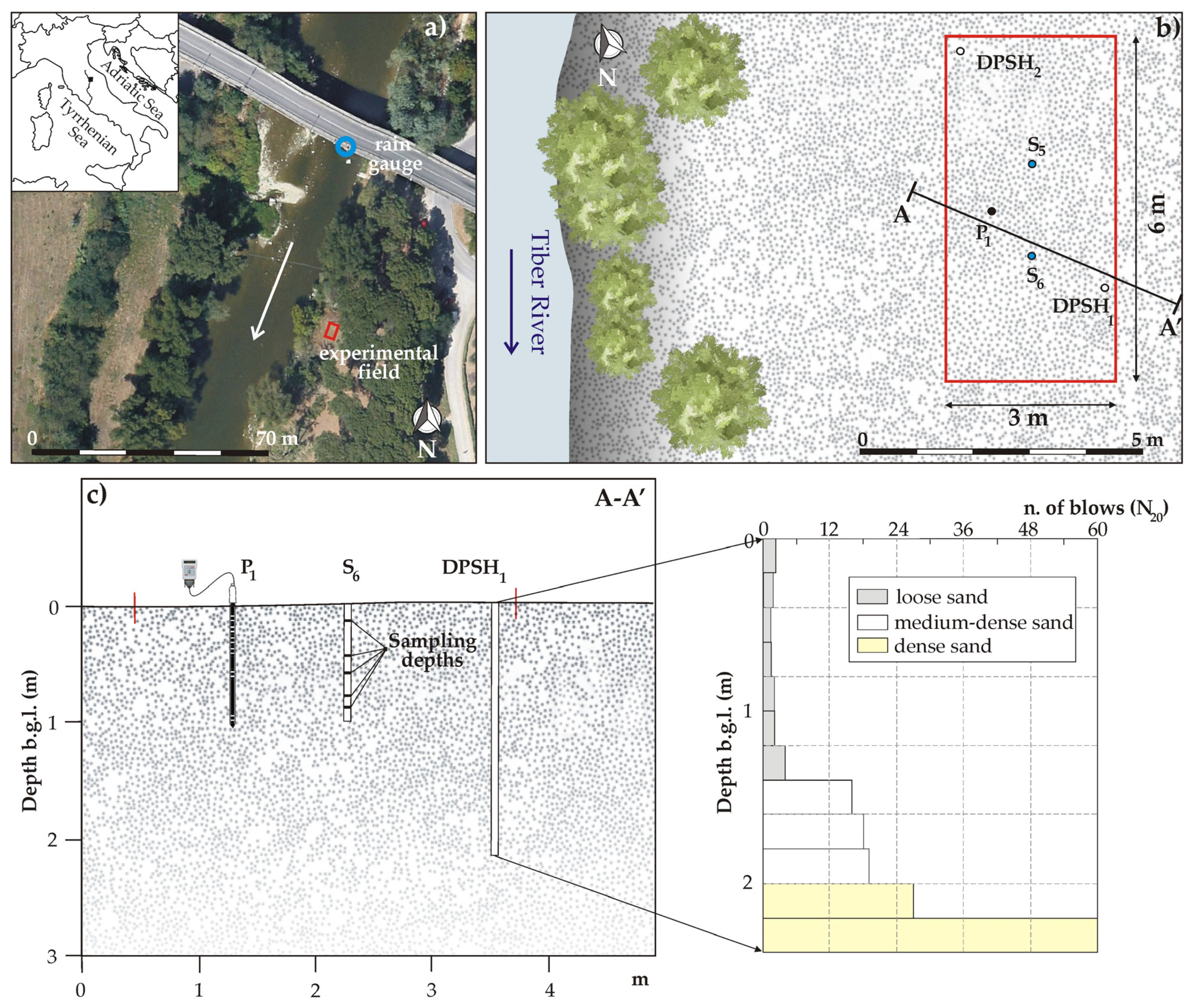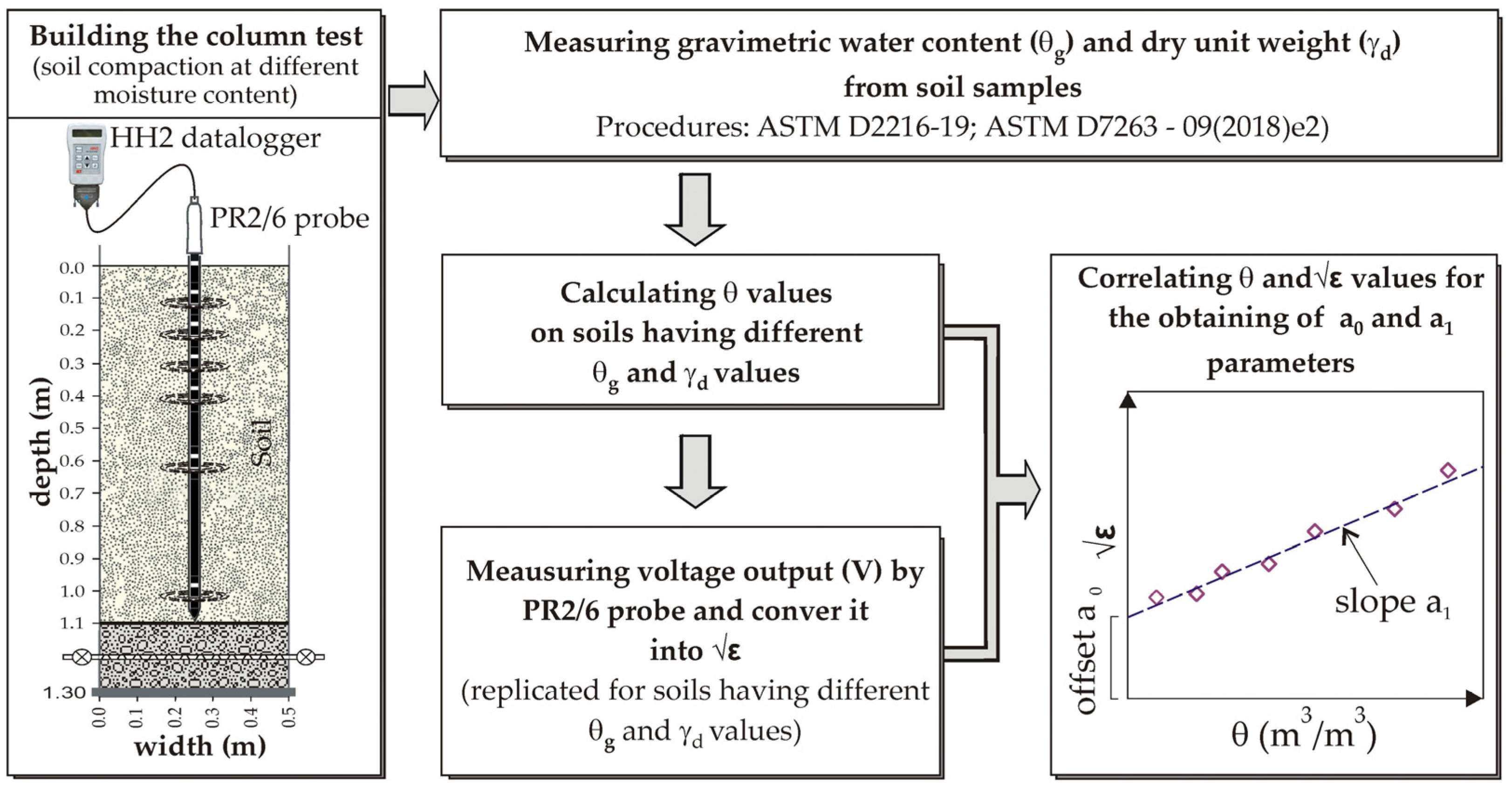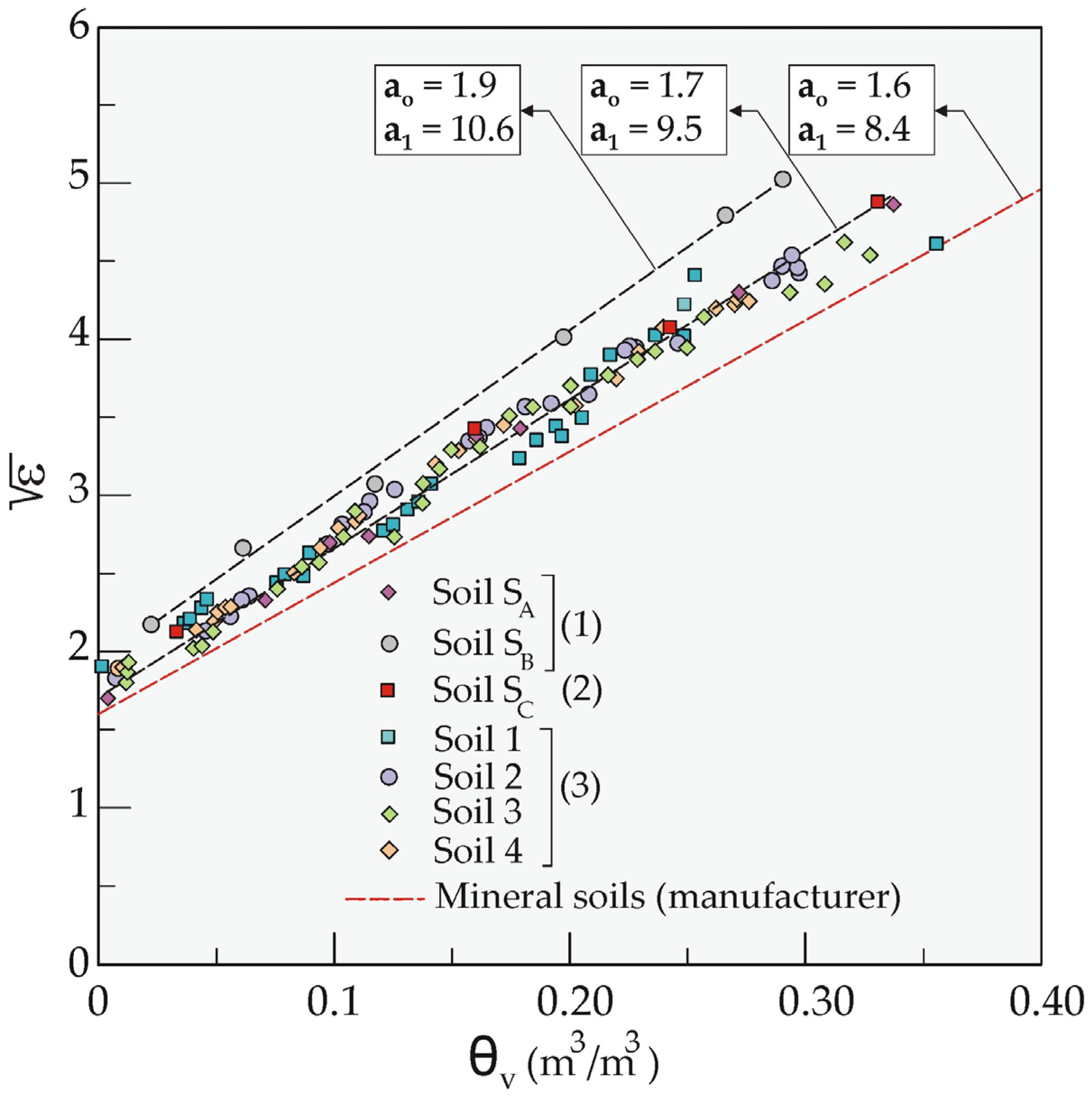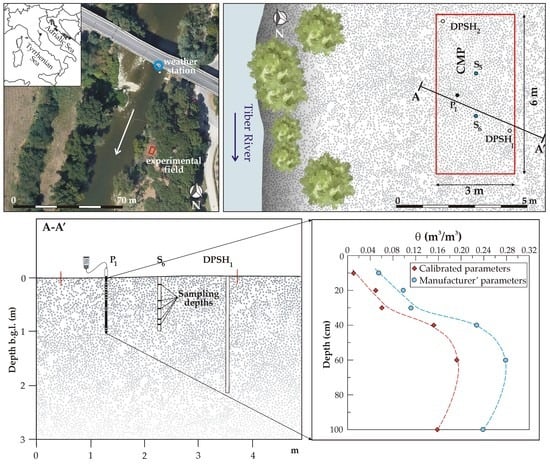Processes in the Unsaturated Zone by Reliable Soil Water Content Estimation: Indications for Soil Water Management from a Sandy Soil Experimental Field in Central Italy
Abstract
1. Introduction
2. Materials and Methods
2.1. Experimental Field and Soil Characteristics
2.2. Monitoring of the Volumetric Water Content and Infiltration
2.2.1. The PR/2 Profile Probe
2.2.2. Double Ring Infiltrometer
- i = infiltration rate (cm/s);
- V = volume of added water (cm3) in each time-step (Δt);
- Δt = time step (s);
- r = radius of the inner ring (cm).
2.3. The Soil Water Characteristic Curve (SWCC)
- σs = suction stress (kN/m2)
- θ = volumetric water content (m3/m3)
- θr = residual volumetric water content (m3/m3)
- θs = saturated volumetric water content (m3/m3)
- ua = pore air pressure (kN/m2)
- uw = pore water pressure (kN/m2)
- (ua − uw) = matric suction (kN/m2)
- Se = effective degree of saturation (m3/m3).
3. Results
3.1. Calibration of PR2/6 Probe on Soil SB and Comparison with Other Sands
3.2. Soil Water Characteristic Curve of Soil SB and Infiltration Test
3.3. Precipitation Analyses and Soil Water Profiles
4. Discussion
5. Conclusions
Supplementary Materials
Author Contributions
Funding
Institutional Review Board Statement
Informed Consent Statement
Data Availability Statement
Acknowledgments
Conflicts of Interest
References
- Keesstra, S.; Mol, G.; De Leeuw, J.; Okx, J.; De Cleen, M.; Visser, S. Soil-related sustainable development goals: Four concepts to make land degradation neutrality and restoration work. Land 2018, 7, 133. [Google Scholar] [CrossRef]
- O’Geen, A.T. Soil Water Dynamics. Nat. Educ. Knowl. 2013, 4, 9. Available online: https://www.nature.com/scitable/knowledge/library/soil-water-dynamics-103089121/ (accessed on 30 November 2020).
- Vanclooster, M. Moditored Unsaturated Soil Transport Processes as a Support for Large Scale Soil and Water Management. EGUGA, 3928. 2010, EGUGA.12.3928V. Available online: https://ui.adsabs.harvard.edu/abs/2010EGUGA.12.3928V/abstract (accessed on 30 November 2020).
- Cosgrove, W.J.; Loucks, D.P. Water management: Current and future challenges and research directions. Water Resour. Res. 2015, 51, 4823–4839. [Google Scholar] [CrossRef]
- Escorihuela, M.J.; Quintana-Seguí, P. Comparison of remote sensing and simulated soil moisture datasets in Mediterranean landscapes. Remote Sens. Environ. 2016, 180, 99–114. [Google Scholar] [CrossRef]
- Di Matteo, L.; Valigi, D.; Cambi, C. Climatic characterization and response of water resources to climate change in limestone areas: Considerations on the importance of geological setting. J. Hydrol. Eng. 2013, 18, 773–779. [Google Scholar] [CrossRef]
- Caloiero, T.; Veltri, S.; Caloiero, P.; Frustaci, F. Drought analysis in Europe and in the Mediterranean basin using the standardized precipitation index. Water 2018, 10, 1043. [Google Scholar] [CrossRef]
- Di Matteo, L.; Dragoni, W.; Maccari, D.; Piacentini, S.M. Climate change, water supply and environmental problems of headwaters: The paradigmatic case of the Tiber, Savio and Marecchia rivers (Central Italy). Sci. Total Environ. 2017, 598, 733–748. [Google Scholar] [CrossRef]
- Molinié, G.; Déqué, M.; Coppola, E.; Blanchet, J.; Neppel, L. Heavy precipitation in the Mediterranean basin. Observed trends, future projections (Sub-chapter 1.3.1.). In The Mediterranean Region under Climate Change: A Scientific Update; Thiébault, S., Moatti, J.P., Eds.; IRD Éditions: Marseille, France, 2016; Available online: https://books.openedition.org/irdeditions/23121#text (accessed on 22 December 2020).
- Mimeau, L.; Tramblay, Y.; Brocca, L.; Massari, C.; Camici, S.; Finaud-Guyot, P. Modeling the response of soil moisture to climate variability in the Mediterranean region. Hydrol. Earth Syst. Sci. Discuss. 2020, 1–29. [Google Scholar] [CrossRef]
- Visser, S.; Keesstra, S.; Maas, G.; De Cleen, M. Soil as a basis to create enabling conditions for transitions towards sustainable land management as a key to achieve the SDGs by 2030. Sustainability 2019, 11, 6792. [Google Scholar] [CrossRef]
- Keesstra, S.D.; Bouma, J.; Wallinga, J.; Tittonell, P.; Smith, P.; Cerdà, A.; Montanarella, L.; Quinton, J.N.; Pachepsky, Y.; van der Putten, W.H.; et al. The significance of soils and soil science towards realization of the United Nations Sustainable Development Goals. Soil 2016, 2, 111–128. [Google Scholar] [CrossRef]
- ASTM D2216-19. Standard Test Methods for Laboratory Determination of Water (Moisture) Content of Soil and Rock by Mass; ASTM International: West Conshohocken, PA, USA, 2019; Available online: https://www.astm.org/Standards/D2216 (accessed on 30 October 2020).
- Walker, J.P.; Willgoose, G.R.; Kalma, J.D. In situ measurement of soil moisture: A comparison of techniques. J. Hydrol. 2004, 293, 85–99. [Google Scholar] [CrossRef]
- Rudnick, D.R.; Djaman, K.; Irmak, S. Performance analysis of capacitance and electrical resistance-type soil moisture sensors in a silt loam soil. Trans. ASABE 2015, 58, 649–665. [Google Scholar] [CrossRef]
- Muñoz-Carpena, R.; Shukla, S.; Morgan, K. Field Devices for Monitoring Soil Water Content; Bulletin 343; University of Florida: Gainesville, FL, USA, 2004; 24p, Available online: https://citeseerx.ist.psu.edu/viewdoc/download?doi=10.1.1.514.6862&rep=rep1&type=pdf (accessed on 31 October 2020).
- Evett, S.R.; Tolk, J.A.; Howell, T.A. Soil profile water content determination: Sensor accuracy, axial response, calibration, temperature dependence, and precision. Vadose Zone J. 2006, 5, 894–907. [Google Scholar] [CrossRef]
- Kizito, F.; Campbell, C.S.; Campbell, G.S.; Cobos, D.R.; Teare, B.L.; Carter, B.; Hopmans, J.W. Frequency, electrical conductivity and temperature analysis of a low-cost capacitance soil moisture sensor. J. Hydrol. 2008, 352, 367–378. [Google Scholar] [CrossRef]
- Chow, L.; Xing, Z.; Rees, H.W.; Meng, F.; Monteith, J.; Stevens, L. Field performance of nine soil water content sensors on a sandy loam soil in New Brunswick, Maritime Region, Canada. Sensors 2009, 9, 9398–9413. [Google Scholar] [CrossRef]
- Kelleners, T.J.; Soppe, R.W.O.; Robinson, D.A.; Schaap, M.G.; Ayars, J.E.; Skaggs, T.H. Calibration of capacitance probe sensors using electric circuit theory. Soil Sci. Soc. Am. J. 2004, 68, 430–439. [Google Scholar] [CrossRef]
- Qi, Z.; Helmers, M.J. The conversion of permittivity as measured by a PR2 capacitance probe into soil moisture values for Des Moines lobe soils in Iowa. Soil Use Manag. 2010, 26, 82–92. [Google Scholar] [CrossRef]
- Adeyemi, O.; Grove, I.; Peets, S.; Norton, T. Advanced monitoring and management systems for improving sustainability in precision irrigation. Sustainability 2017, 9, 353. [Google Scholar] [CrossRef]
- Di Matteo, L.; Pauselli, C.; Valigi, D.; Ercoli, M.; Rossi, M.; Guerra, G.; Cambi, C.; Ricco, R.; Vinti, G. Reliability of water content estimation by profile probe and its effect on slope stability. Landslides 2018, 15, 173–180. [Google Scholar] [CrossRef]
- Weihermüller, L.; Huisman, J.A.; Lambot, S.; Herbst, M.; Vereecken, H. Mapping the spatial variation of soil water content at the field scale with different ground penetrating radar techniques. J. Hydrol. 2007, 340, 205–216. [Google Scholar] [CrossRef]
- Ercoli, M.; Di Matteo, L.; Pauselli, C.; Mancinelli, P.; Frapiccini, S.; Talegalli, L.; Cannata, A. Integrated GPR and laboratory water content measures of sandy soils: From laboratory to field scale. Constr. Build. Mater. 2018, 159, 734–744. [Google Scholar] [CrossRef]
- Brocca, L.; Hasenauer, S.; Lacava, T.; Melone, F.; Moramarco, T.; Wagner, W.; Dorigo, W.; Matgen, P.; Martínez-Fernández, J.; Llorens, P.; et al. Soil moisture estimation through ASCAT and AMSR-E sensors: An intercomparison and validation study across Europe. Remote Sens. Environ. 2011, 115, 3390–3408. [Google Scholar] [CrossRef]
- Morbidelli, R.; Corradini, C.; Saltalippi, C.; Brocca, L. Initial soil water content as input to field-scale infiltration and surface runoff models. Water Resour. Manag. 2012, 26, 1793–1807. [Google Scholar] [CrossRef]
- Naz, B.S.; Kollet, S.; Franssen, H.J.H.; Montzka, C.; Kurtz, W. A 3 km spatially and temporally consistent European daily soil moisture reanalysis from 2000 to 2015. Sci. Data 2015, 7, 1–14. [Google Scholar] [CrossRef] [PubMed]
- Rowlandson, T.L.; Berg, A.A.; Bullock, P.R.; Ojo, E.R.; McNairn, H.; Wiseman, G.; Cosh, M.H. Evaluation of several calibration procedures for a portable soil moisture sensor. J. Hydrol. 2013, 498, 335–344. [Google Scholar] [CrossRef]
- Robinson, D.A.; Gardner, C.M.K.; Cooper, J.D. Measurement of relative permittivity in sandy soils using TDR, capacitance and theta probes: Comparison, including the effects of bulk soil electrical conductivity. J. Hydrol. 1999, 223, 198–211. [Google Scholar] [CrossRef]
- Bogena, H.R.; Huisman, J.A.; Oberdörster, C.; Vereecken, H. Evaluation of a low-cost soil water content sensor for wireless network applications. J. Hydrol. 2007, 344, 32–42. [Google Scholar] [CrossRef]
- Domínguez-Niño, J.M.; Bogena, H.R.; Huisman, J.A.; Schilling, B.; Casadesús, J. On the accuracy of factory-calibrated low-cost soil water content sensors. Sensors 2019, 19, 3101. [Google Scholar] [CrossRef]
- Jiménez-de-Santiago, D.E.; Lidón, A.; Bosch-Serra, À.D. Soil water dynamics in a rainfed Mediterranean agricultural system. Water 2019, 11, 799. [Google Scholar] [CrossRef]
- Ferrarezi, R.S.; Nogueira, T.A.R.; Zepeda, S.G.C. Performance of Soil Moisture Sensors in Florida Sandy Soils. Water 2020, 12, 358. [Google Scholar] [CrossRef]
- Kim, H.; Cosh, M.H.; Bindlish, R.; Lakshmi, V. Field evaluation of portable soil water content sensors in a sandy loam. Vadose Zone J. 2020, 19, e20033. [Google Scholar] [CrossRef]
- ElNesr, M.N.; Alazba, A.A.; El-Farrah, M.A. Correcting inaccurately recorded data due to faulty calibration of a capacitance water content probe. Appl. Environ. Soil Sci. 2013, 530732. [Google Scholar] [CrossRef]
- Shaikh, J.; Yamsani, S.K.; Sekharan, S.; Rakesh, R.R. Performance Evaluation of Profile Probe for Continuous Monitoring of Volumetric Water Content in Multilayered Cover System. J. Environ. Eng. 2018, 144, 04018078. [Google Scholar] [CrossRef]
- ASTM D422-63(2007)e2. Standard Test Method for Particle-Size Analysis of Soils; ASTM International: West Conshohocken, PA, USA, 2007; Available online: https://www.astm.org/Standards/D422 (accessed on 30 October 2020).
- ASTM D2974—20e1. Standard Test Method for Particle-Size Analysis of Soils; ASTM International: West Conshohocken, PA, USA, 2019; Available online: https://www.astm.org/Standards/D2974.htm (accessed on 30 October 2020).
- Delta-T Devices Ltd. User Manual for the Profile Probe, Type PR2; Delta-T Devices Ltd.: Cambridge, UK, 2008; 48p, Available online: https://www.delta-t.co.uk/wp-content/uploads/2017/02/PR2_user_manual_version_5.0.pdf (accessed on 30 October 2020).
- Topp, G.C.; Davis, J.L.; Annan, A.P. Electromagnetic determination of soil water content: Measurement in coaxial transmission lines. Water Resour. Res. 1980, 16, 579–582. [Google Scholar] [CrossRef]
- Rüdiger, C.; Western, A.W.; Walker, J.P.; Smith, A.B.; Kalma, J.D.; Willgoose, G.R. Towards a general equation for frequency domain reflectometers. J. Hydrol. 2010, 383, 319–329. [Google Scholar] [CrossRef]
- Sevostianova, E.; Deb, S.; Serena, M.; VanLeeuwen, D.; Leinauer, B. Accuracy of two electromagnetic soil water content sensors in saline soils. Soil Sci. Soc. Am. J. 2015, 79, 1752–1759. [Google Scholar] [CrossRef]
- Vaz, C.M.; Jones, S.; Meding, M.; Tuller, M. Evaluation of standard calibration functions for eight electromagnetic soil moisture sensors. Vadose Zone J. 2013, 12, 1–16. [Google Scholar] [CrossRef]
- ASTM D3385-18. Standard Test Method for Infiltration Rate of Soils in Field Using Double-Ring Infiltrometer; ASTM International: West Conshohocken, PA, USA, 2018; Available online: https://www.astm.org/Standards/D3385.htm (accessed on 30 October 2020).
- Fatehnia, M.; Tawfiq, K.; Ye, M. Estimation of saturated hydraulic conductivity from double-ring infiltrometer measurements. Eur. J. Soil Sci. 2016, 67, 135–147. [Google Scholar] [CrossRef]
- Fredlund, D.G.; Rahardjo, H. Soil Mechanics for Unsaturated Soils; John Wiley & Sons: New York, NY, USA, 1993. [Google Scholar]
- Lu, N.; Likos, W.J. Unsaturated Soil Mechanics; John Wiley: New York, NY, USA, 2004; 556p. [Google Scholar]
- Wang, L.; Cao, Z.J.; Li, D.Q.; Phoon, K.K.; Au, S.K. Determination of site-specific soil-water characteristic curve from a limited number of test data–A Bayesian perspective. Geosci. Front. 2018, 9, 1665–1677. [Google Scholar] [CrossRef]
- Saxton, K.E.; Rawls, W.J. Soil water characteristic estimates by texture and organic matter for hydrologic solutions. Soil Sci. Soc. Am. J. 2006, 70, 1569–1578. [Google Scholar] [CrossRef]
- Saxton, K.E.; Rawls, W.J.; Romberger, J.S.; Papendick, R.I. Estimating generalized soil water characteristics from texture. Trans. Am. Soc. Agric. Eng. 1986, 50, 1031–1035. [Google Scholar]
- Di Matteo, L. Liquid limit of low-to medium-plasticity soils: Comparison between Casagrande cup and cone penetrometer test. Bull. Eng. Geol. Environ. 2012, 71, 79–85. [Google Scholar] [CrossRef]
- Horton, R.E. An approach toward a physical interpretation of infiltration capacity. Proc. Soil Sci. Soc. Am. 1940, 5, 399–417. [Google Scholar] [CrossRef]
- Fetter, C.W. Applied Hydrogeology; Waveland Press Inc.: New York, NY, USA, 2001. [Google Scholar]
- Kargas, G.; Londra, P.; Anastasatou, M.; Moustakas, N. The Effect of Soil Iron on the Estimation of Soil Water Content Using Dielectric Sensors. Water 2020, 12, 598. [Google Scholar] [CrossRef]
- Gubbiotti, F. Determinazione Sperimentale della Conducibilità Termica nei Materiali Sabbiosi in Funzione del Grado di Addensamento e del Contenuto in Acqua. Master’s Thesis, Università degli Studi di Perugia, Perugia, Italy, 2019. Unpublished. [Google Scholar]
- Robinson, D.A.; Bell, J.; Batchelor, C. Influence of iron minerals on the determination of soil water content using dielectric techniques. J. Hydrol. 1994, 161, 169–180. [Google Scholar] [CrossRef]
- Haga, H.; Matsumoto, Y.; Matsutani, J.; Fujita, M.; Nishida, K.; Sakamoto, Y. Flow paths, rainfall properties, and antecedent soil moisture controlling lags to peak discharge in a granitic unchanneled catchment. Water Resour. Res. 2005, 41, W12410. [Google Scholar] [CrossRef]
- Penna, D.; Mantese, N.; Hopp, L.; Dalla Fontana, G.; Borga, M. Spatio-temporal variability of piezometric response on two steep alpine hillslopes. Hydrol. Process. 2015, 29, 198–211. [Google Scholar] [CrossRef]
- Scaife, C.I.; Band, L.E. Nonstationarity in threshold response of stormflow in southern Appalachian headwater catchments. Water Resour. Res. 2017, 53, 6579–6596. [Google Scholar] [CrossRef]
- Keesstra, S.; Nunes, J.P.; Saco, P.; Parsons, T.; Poeppl, R.; Masselink, R.; Cerdà, A. The way forward: Can connectivity be useful to design better measuring and modelling schemes for water and sediment dynamics? Sci. Total Environ. 2018, 644, 1557–1572. [Google Scholar] [CrossRef]
- Zhao, L.; Hou, R.; Wu, F.; Keesstra, S. Effect of soil surface roughness on infiltration water, ponding and runoff on tilled soils under rainfall simulation experiments. Soil Tillage Res. 2018, 179, 47–53. [Google Scholar] [CrossRef]
- Tóth, G.; Hermann, T.; da Silva, M.R.; Montanarella, L. Monitoring soil for sustainable development and land degradation neutrality. Environ. Monit. Assess. 2018, 190, 57. [Google Scholar] [CrossRef] [PubMed]
- Morvan, X.; Saby, N.P.A.; Arrouays, D.; Le Bas, C.; Jones, R.J.A.; Verheijen, F.G.A.; Bellamy, P.H.; Stephens, M.; Kibblewhite, M.G. Soil monitoring in Europe: A review of existing systems and requirements for harmonization. Sci. Total Environ. 2008, 391, 1–12. [Google Scholar] [CrossRef] [PubMed]
- Dexter, A.R. Soil physical quality: Part I. Theory, effects of soil texture, density, and organic matter, and effects on root growth. Geoderma 2004, 120, 201–214. [Google Scholar] [CrossRef]
- Di Prima, S.; Rodrigo-Comino, J.; Novara, A.; Iovino, M.; Pirastru, M.; Keesstra, S.; Cerdà, A. Soil physical quality of citrus orchards under tillage, herbicide, and organic managements. Pedosphere 2018, 28, 463–477. [Google Scholar] [CrossRef]






| Name | Source | Origin | Grain Size (%) | OM (%) | Mineralogy | ||
|---|---|---|---|---|---|---|---|
| Sand | Silt | Clay | |||||
| Soil SA | [23] | Nera River (Central Italy) | 95.25 | 3.45 | 1.30 | 0.37 | Carbonates with subordinate minerals (muscovite, gypsum) |
| Soil SB | [23] | Tiber River (Central Italy) | 82.41 | 14.59 | 3 | 1.53 | Flyschoid sand (quartz, calcite, albite, chlorite muscovite, pyrite, and orthoclase) |
| Soil SC | Unpublished data | Paglia River (Central Italy) | 94.61 | 3.90 | 1.49 | 0.23 | - |
| Soil 1 | [30] | England and Northern Ireland | 99.30 | 0 | 0.70 | 0.36 | Quartz |
| Soil 2 | [30] | England and Northern Ireland | 97.20 | 2.40 | 0.40 | 1.07 | Quartz |
| Soil 3 | [30] | England and Northern Ireland | 66.20 | 1.10 | 1.03 | 1.03 | Quartz (>5% iron oxide/Kaolinite) |
| Soil 4 | [30] | England and Northern Ireland | 95.50 | 4.20 | 0.30 | 2.06 | Quartz |
Publisher’s Note: MDPI stays neutral with regard to jurisdictional claims in published maps and institutional affiliations. |
© 2020 by the authors. Licensee MDPI, Basel, Switzerland. This article is an open access article distributed under the terms and conditions of the Creative Commons Attribution (CC BY) license (http://creativecommons.org/licenses/by/4.0/).
Share and Cite
Di Matteo, L.; Spigarelli, A.; Ortenzi, S. Processes in the Unsaturated Zone by Reliable Soil Water Content Estimation: Indications for Soil Water Management from a Sandy Soil Experimental Field in Central Italy. Sustainability 2021, 13, 227. https://doi.org/10.3390/su13010227
Di Matteo L, Spigarelli A, Ortenzi S. Processes in the Unsaturated Zone by Reliable Soil Water Content Estimation: Indications for Soil Water Management from a Sandy Soil Experimental Field in Central Italy. Sustainability. 2021; 13(1):227. https://doi.org/10.3390/su13010227
Chicago/Turabian StyleDi Matteo, Lucio, Alessandro Spigarelli, and Sofia Ortenzi. 2021. "Processes in the Unsaturated Zone by Reliable Soil Water Content Estimation: Indications for Soil Water Management from a Sandy Soil Experimental Field in Central Italy" Sustainability 13, no. 1: 227. https://doi.org/10.3390/su13010227
APA StyleDi Matteo, L., Spigarelli, A., & Ortenzi, S. (2021). Processes in the Unsaturated Zone by Reliable Soil Water Content Estimation: Indications for Soil Water Management from a Sandy Soil Experimental Field in Central Italy. Sustainability, 13(1), 227. https://doi.org/10.3390/su13010227







